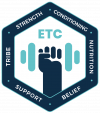Information around training and pregnancy can be confusing… Some people say it’s dangerous and should be avoided, others say you should keep training and can do what you were doing before you were pregnant, and still others will tell you that you must immediately change how you train as soon as you find out…
Hopefully this blog will help you make your own decisions about training when pregnant, and leave you more informed on what your choices are, whether you are a well trained individual or someone who has little experience but has been informed they need to train by a healthcare professional.
What are the dos and don’ts of training when pregnant?
There are very few absolutes when it comes to training, and even in pregnancy this is the case. Every woman, and every pregnancy will be different- even if you are on pregnancy 2 or 3!
A key thing for training when pregnant is to listen to your body, there may be some movements that your body or gut feeling tells you not to do. Generally if this is the case, either approach those movements with caution, or avoid them.
When you are comfortable sharing the news, inform your PT so that they can modify sessions for you and help make your training better suited to you as you progress through the trimesters.
Can I keep training like I was before I was pregnant?
The answer is Yes, and No. There are reasons why you should modify your training, especially if you enjoy doing High Intensity Interval Training (HIIT) as part of your training regime, or you are involved in contact sports or motor sports.
The general advice for training is to avoid exercise that pushes you into the 85% or higher heart rate zones, so HIIT or intense sprint training will need to be modified to ensure heart rate is managed to lower levels, and will need to be slowly phased out in the later stages of pregnancy.
Contact sports and motor sports are generally advised to be stopped once you know you are pregnant to avoid the risk to the growing fetus from heavy contact, or fall damage.
HOWEVER all is not lost! Resistance training can, and probably should be continued. Even better if you work with a PT who understands training through pregnancy.
In general you can keep doing the movements you love in resistance training all the way through your pregnancy, even late into the 3rd trimester. There will of course be some modifications, mostly around load and positioning of self, but with care it is doable, and definitely advisable!
Considerations for resistance training
Pelvic floor work, diaphragmatic breathing and posture
I have grouped these three things and put them before we break down each trimester simply because these are the key movements to keep throughout your pregnancy, they are movements or exercises that will help prime you for further exercise, but also help with some of the aches and pains of pregnancy.
Pelvic floor work: Learning how to relax and tense your pelvic floor with breath work will be a useful tool, when exercising, but also for preparation for birth as you will be able to control what your pelvic floor does (relax and tense accordingly with contractions). Below is a great video on how to start practicing the connection breath for pelvic floor health!
Moms Gone Strong – Pregnancy Connection Breath
Diaphragmatic breathing: As your baby grows you may notice your breathing becoming more challenged, especially in the later trimesters. This is because the growing fetus will be adding pressure onto your diaphragm, as well as all your internal organs, forcing them upwards! Adding diaphragmatic breathing into your warm up/ cool down or just as a means of relaxation will help keep your breathing in check, and will allow you to return to better breathing patterns post birth! Check out the below video for a great explanation of diaphragmatic breath work and some useful tips!
Diaphragmatic Breathing – Modern Woman’s Guide to Strength Training
Posture and alignment work: As your baby grows you may notice your posture changes, there is more weight in the front of your body, pulling your hips and spine into a different alignment. Generally this will manifest in a sore lower back and hips, but can also affect your upper back, shoulder and neck too! Spending time working on your posture, and the alignment of your hips, back and shoulders in the early stages will help you when you reach the final stretch when your little bump isn’t so little anymore! Some key areas to keep in mind are your glutes, core (not just the abs) and upper back. Check out the below links for some simple movements that will help you with these areas:
Moms Gone Strong – Tall Kneeling Hover– Great for your glutes and pelvic floor
Moms Gone Strong – Pregnancy Band Pull-Apart– Keep your shoulders happy
Moms Gone Strong – Open Book Exercise– Lovely twisty spine stretch for your whole back, shoulders and beyond!
First trimester: (weeks 1-13)
Generally your training can look very similar to how you were training before you were pregnant, and depending on when you found out, you may well have been training in the early stages already!
Be aware of how you feel during sessions, you will still need to keep your heart rate within or below the 85% max range, you may be suffering with morning sickness, fatigue and nausea. For some women training can help alleviate these symptoms, for others they can worsen them.
If you are feeling the effects of nausea, or morning sickness and fatigue but can train as it makes you feel better, we would suggest you modify the intensity of your sessions to less intense, either by increasing rest times, reducing load or rep schemes to more manageable ranges.
Second trimester: (weeks 14-27)
The second trimester can be a mixed bag, for many women there will be an easing of morning sickness/ nausea symptoms, you may feel less drained and have more energy again! Obviously this isn’t the case for everyone, you may continue to have morning sickness or nausea throughout your pregnancy, if this is the case your continuation of training will need to be discussed with your healthcare professional/ midwife!
As your baby grows you may find certain positions harder to get into, either because of the size of your bump, or they may just be uncomfortable. You may need to look at doing movements in a seated or standing position rather than lying down. You can still perform movements in a lying position but you will need to be aware of these key things; Lightheadedness, nausea or breathlessness. If these are experienced it would be preferable to work with a slight incline (15 degrees or more) and removing lying positions from all further sessions.
As the baby grows the pressure on your pelvic floor will increase, so high impact movements may need to be scaled to lower impact options, this is especially important if you feel any heaviness in your perineum, or pelvic floor. You will also need to take into consideration certain barbell movements, to avoid contact with the bump (barbell cleans and similar) which may need scaling to dumbbell alternatives, or avoiding if uncomfortable.
Third trimester: (28 weeks- birth)
Generally the biggest consideration by this point will be ensuring training is manageable as fatigue will play a major factor in the final trimester. This is a time of rapid growth for the baby which will drain your own energy reserves, so be aware of how you are feeling, you may need to reduce your intensity levels in training greatly, so longer rest periods, lighter weights and manageable rep ranges.
The other key area to be aware of will be diastasis rectus abdominis, the separation of your abdominal muscles, in particular doming or bulging along the midline. If this doming or bulging is observed, stop the exercise you are performing and look for an alternative. Common culprits that cause this effect include planks, crunches or high- load front loading positions (front squats, front rack holds etc). However be aware of it in all movements, every person is different and you may notice it in another movement.
You may want to consider doing more mobility work in sessions in place of a ‘finisher’ or as part of your strength training block. Simple exercises such as cat/cow, thread the needle, or pelvic tilts may help reduce some of the general stiffness and pain associated with the third trimester. Positions like cat/cow, wide child’s pose and butterfly position can also help to position the baby in an optimal position for birth.




